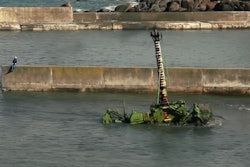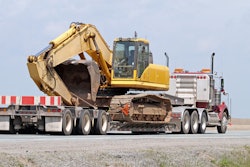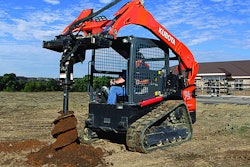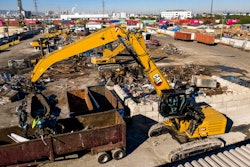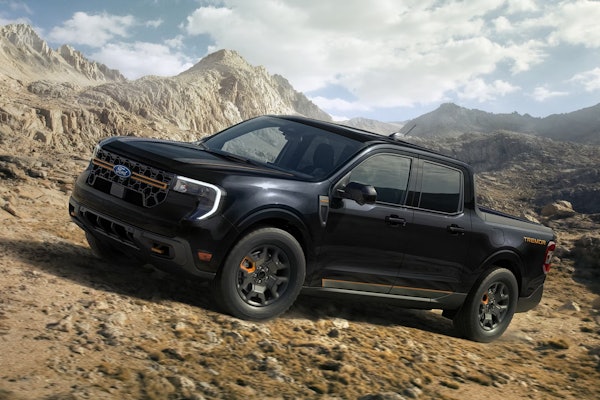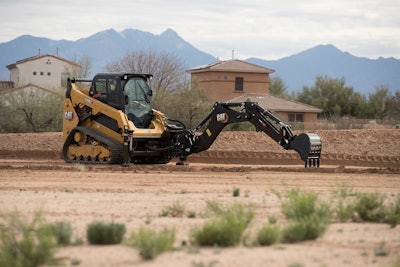
More than a third – 37 out of 87 – of the compact track loaders in the Equipment World Spec Guide are listed as new by their manufacturers.
This isn’t surprising. Compared with their nearest equipment kin – skid steers – CTLs are relative newcomers to the industry. So CTLs remain in a phase of development that includes rapid advances.
Two other factors propel CTL development. First is their broad, enthusiastic acceptance by customers. Maintaining market share requires OEMs to stay at the forefront of product development.
Second, the industry as a whole continues to make great gains in technology as advances in electronics, metallurgy and basic design bring peak performance to all types of equipment. This is as true for CTLs as for any other category.
The downside? In a world of relentless product development, it can be hard for customers to feel assured they’re getting the best from their equipment decisions. So, we've provided some tips from experts to help you learn more about the new compact track loaders and what you should look for when searching the market for your next CTL.
Take time to study new models
There are going to be a lot of newcomers on the market since you bought your last CTL, so take the time to study what they offer. Here are some examples.
Bobcat's new R-Series consists of four models, the T62, T64, T66 and T76. The T62 is radial-lift and the others are vertical. All four feature Bobcat’s optional five-link torsion suspension, which improves ride quality and machine stability, especially at full lift. Engines are now mounted inline rather than transverse. This provides more space for emissions-control components but also boosts rated operating capacity 200 to 300 pounds by creating slightly longer machines. Their width is comparable to R-Series’ predecessors.
R-Series machines also have greater lift and reach than the models they replace. Engine placement and a larger fan contribute to overall improved cooling performance, especially when running attachments. LED lights are standard equipment. A prefilter has been placed ahead of the main fuel filter. “Everything about the new R-Series really is new,” says Tyler Zima, senior product specialist, Bobcat.
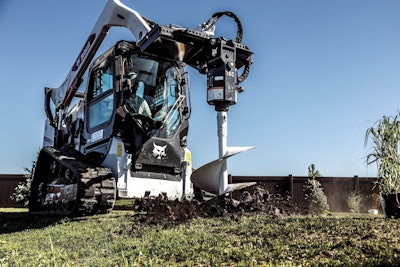 The Bobcat T66 has an 8,927-pound operating weight and a 2,450-pound ROC. Travel speed is 7.2 mph, or 10.2 mph with optional two-speed drive. System pressure at the quick couplers is 3,500 psi. Standard auxiliary flow is 17.6 gallons per minute and 26.9 gpm with optional high flow. Length with the standard bucket is 134.9 inches. Height to bucket pin is 120 inches, and reach at maximum height is 36.7 inches.
The Bobcat T66 has an 8,927-pound operating weight and a 2,450-pound ROC. Travel speed is 7.2 mph, or 10.2 mph with optional two-speed drive. System pressure at the quick couplers is 3,500 psi. Standard auxiliary flow is 17.6 gallons per minute and 26.9 gpm with optional high flow. Length with the standard bucket is 134.9 inches. Height to bucket pin is 120 inches, and reach at maximum height is 36.7 inches.
Much of that refinement is directed at the working envelope. Visibility is enhanced everywhere, most notably to the bucket corners and the edges of the tracks. There’s about 3 inches of additional space between the joysticks; this provides more knee room and opens up more foot placement options. An available performance package offers dual self-levelling, work tool positioning and return-to-dig.
D3 models are also compatible with all three of Cat’s Smart attachments: grader blade with assist, dozer blade with assist and backhoe. Joystick controls can be converted to match the needs of these Smart attachments for more intuitive control.
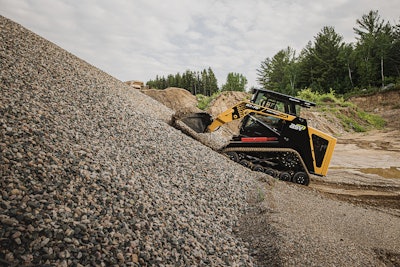 The ASV RT-75 is one of four models of Max-Series Posi-Trak loaders. Improvements are extensive, including those to the cabs. A single-sided lap bar enhances operator comfort and provides easier entry and exit. Space has been added at the shoulders, knees and footwell. The optional enclosed cab has 52% more glass space for better visibility and has a roof escape hatch. The 74-horsepower radial-lift RT-75 has an operating weight of 9,060 pounds and an ROC of 2,750 pounds.
The ASV RT-75 is one of four models of Max-Series Posi-Trak loaders. Improvements are extensive, including those to the cabs. A single-sided lap bar enhances operator comfort and provides easier entry and exit. Space has been added at the shoulders, knees and footwell. The optional enclosed cab has 52% more glass space for better visibility and has a roof escape hatch. The 74-horsepower radial-lift RT-75 has an operating weight of 9,060 pounds and an ROC of 2,750 pounds.
He says operator comfort and visibility are examples of features that must be experienced to be fully appreciated. Storlie says this is especially true for the Max-Series CTLs introduced in 2020, in which cab improvements were part of the extensive changes in design.
But there can be some downsides to some new features, says Ryan Anderson, product marketing manager, New Holland Construction. Advanced electronics, emissions control systems and other new features introduce new failure modes, he says. “Sometimes it seems the market’s thinking is, ‘What’s the next widget we can put on this machine?’”
A key consideration when evaluating new models is reliability, Anderson says. “Early machines were extremely durable. You still hear customers lament, ‘They just don’t make 'em like they used to.’ For this reason, New Holland pays strict attention to durability in the design of new features.”
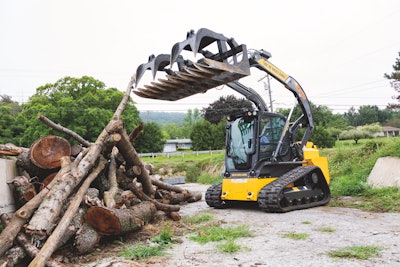 The 74-net-horsepower C332 from New Holland features the Super Boom vertical-lift package with a bucket hinge pin height of 131.1 inches and dump reach at full lift of 34.4 inches at 45 degrees. Standard flow is 24.2 gallons per minute with a 37.6 gpm high-flow option. Relief pressure is 3,046 psi. Operating weight is 9,630 pounds, and ROC is 2,240 pounds. Bucket breakout force is 7,360 pounds.
The 74-net-horsepower C332 from New Holland features the Super Boom vertical-lift package with a bucket hinge pin height of 131.1 inches and dump reach at full lift of 34.4 inches at 45 degrees. Standard flow is 24.2 gallons per minute with a 37.6 gpm high-flow option. Relief pressure is 3,046 psi. Operating weight is 9,630 pounds, and ROC is 2,240 pounds. Bucket breakout force is 7,360 pounds.
Spec’ing a new model
New models have so much potential that spec’ing a new machine is far more complex than in the past. This is especially true if the CTL is going to be more than a bucket-and-forks machine for the customer.
“John Deere has over 100 attachments for compact equipment, including compact track loaders, available from the factory,” says Luke Gribble, solutions marketing manager, Deere. “Ask yourself, ‘What kind of jobs am I going after?’ Look beyond the one main attachment you use.” And even if it’s always going to be a bucket, consider material density – rock, dirt, mulch, etc. – to make sure the machine will handle the load.
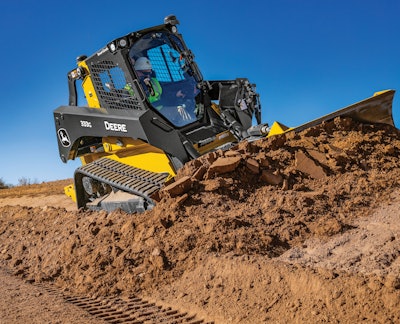 With its 3,700-pound ROC and 12,100-pound operating weight, the 333G is the largest of Deere’s four CTL models. The intercooled, turbocharged Yanmar engine provides 100 gross horsepower and 291.3 foot-pounds of torque. The vertical-lift machine has a hinge pin height of 132 inches. An onboard grade indication option can be installed from the factory or in the field and provides real-time roll and pitch values in either degrees or percentages.
With its 3,700-pound ROC and 12,100-pound operating weight, the 333G is the largest of Deere’s four CTL models. The intercooled, turbocharged Yanmar engine provides 100 gross horsepower and 291.3 foot-pounds of torque. The vertical-lift machine has a hinge pin height of 132 inches. An onboard grade indication option can be installed from the factory or in the field and provides real-time roll and pitch values in either degrees or percentages.
Matching connectors is not enough; controls must also be matched. “Look at the grips. Are there multiple circuits? A plus B functions? Are there enough buttons and are they configured properly?” Adams says. Wacker Neuson CTLs offer a D Mode whereby grip button functions are reassigned for added convenience and efficiency.
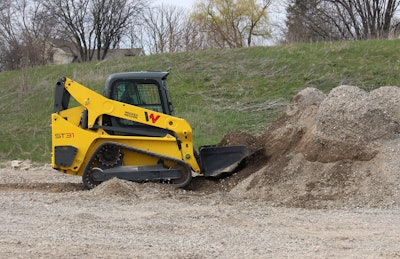 The 8,095-pound ST31 is the second-smallest CTL in the Wacker Neuson six-model line. This size remains popular with landscapers, owner-operators and others looking for CTL performance in a smaller package. Overall length with the standard bucket is 136.6 inches. Hinge pin height is 125.5 inches, and overall width is 67.1 inches. The Kohler KDI 2504 TCR engine is rated at 74 horsepower. Standard auxiliary hydraulic flow is 20 gallons per minute with a 30 gpm high-flow option available.
The 8,095-pound ST31 is the second-smallest CTL in the Wacker Neuson six-model line. This size remains popular with landscapers, owner-operators and others looking for CTL performance in a smaller package. Overall length with the standard bucket is 136.6 inches. Hinge pin height is 125.5 inches, and overall width is 67.1 inches. The Kohler KDI 2504 TCR engine is rated at 74 horsepower. Standard auxiliary hydraulic flow is 20 gallons per minute with a 30 gpm high-flow option available.
He also advises against making assumptions about the need for system upgrades. “No matter what your needs have been in the past, you may find that the newer, more capable machines meet those needs in standard configuration. High flow still has its place, but requiring it in the past does not necessarily indicate a need for it in the future for doing the same work.”
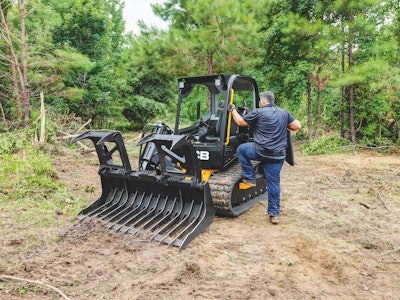 JCB offers multiple configurations of its 270T vertical-lift machine. The most popular configuration includes 17.7-inch rubber tracks, cab with heat and air conditioning, high-flow hydraulics with creep speed, two-speed drive and JCB Smoothride System. Operating weight is 11,003 pounds, and ROC is 2,723 pounds. As with all JCB CTLs, the 270T features an industry standard quick hitch for simple coupling to attachments from JCB as well as other manufacturers.
JCB offers multiple configurations of its 270T vertical-lift machine. The most popular configuration includes 17.7-inch rubber tracks, cab with heat and air conditioning, high-flow hydraulics with creep speed, two-speed drive and JCB Smoothride System. Operating weight is 11,003 pounds, and ROC is 2,723 pounds. As with all JCB CTLs, the 270T features an industry standard quick hitch for simple coupling to attachments from JCB as well as other manufacturers.
“When you buy a CTL, you expect that asset to live in your fleet for many years,” MacIntyre adds. “If you expect to grow your business and expand your services, you don’t want to be limited by auxiliary hydraulic performance.”
Blane Burroughs, product specialist, Kubota, notes that sophisticated attachments need sophisticated protection. “We offer a guard protection package for several models of our track loaders. The kit includes coupler guards, lights guards, a DEF guard and additional protection for the FOPS and engine compartment.”
New machine, new markets?
The current lineup of compact track loaders will allow customers to do the same work they’ve always done with greater efficiency and productivity, but should the advantages stop there? If these machines are so capable, do they provide an opportunity for owners to offer more services to the same client base or even enter entirely new markets?
“The attachments available for CTLs and the availability of high-flow hydraulics can significantly expand your capabilities and help grow your business,” MacIntyre says. He mentions landscapers and concrete companies that already use CTLs for their main applications. “With a mulching attachment, they can do clearing and site prep for residential work.”
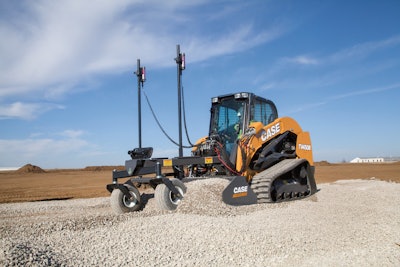 The vertical-lift TV450B is the largest of the five-model lineup of Case B Series CTLs and has features shared by all B Series models. Electrohydraulic control response can be set to low, moderate or aggressive. Creep speed allows slow travel while providing full hydraulic power to attachments. Operator profiles can be set to match individual preferences or best settings by job types. New fault codes with descriptive text facilitate troubleshooting.
The vertical-lift TV450B is the largest of the five-model lineup of Case B Series CTLs and has features shared by all B Series models. Electrohydraulic control response can be set to low, moderate or aggressive. Creep speed allows slow travel while providing full hydraulic power to attachments. Operator profiles can be set to match individual preferences or best settings by job types. New fault codes with descriptive text facilitate troubleshooting.
Lee Padgett, product manager, Takeuchi, lists other opportunities. “There are tree spade attachments for nursery work, power rakes for soil conditioning, mulchers and mowers for managing large tracts of vegetation, and trenchers for installing utilities and irrigation.”
Zima says the market is split on this matter. “Smaller CTLs will continue to do much of the same work they always have. Larger-horsepower machines have the greatest opportunity to move into other markets.”
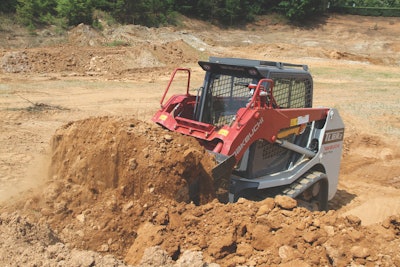 Features of the radial-lift Takeuchi TL8R2 include repositioned travel motors with internally routed drive lines, double and triple flange track rollers and LED lighting. Options include creep mode, load-sensing auto shift and high-flow auxiliary hydraulics. Operating weight with cab is 9,182 pounds, and ROC is 2,116 pounds.
Features of the radial-lift Takeuchi TL8R2 include repositioned travel motors with internally routed drive lines, double and triple flange track rollers and LED lighting. Options include creep mode, load-sensing auto shift and high-flow auxiliary hydraulics. Operating weight with cab is 9,182 pounds, and ROC is 2,116 pounds.
Narrowing the gap
There have always been gaps between compact track loaders and skid steer loaders. Most notable is upfront cost, but ongoing O&O costs, travel speed and ROC create additional differences. What efforts have OEMs made to close these gaps and increase the appeal of CTLs to customers considering either a CTL or skid steer?
“We strive to have common parts between our skid and track loaders,” says Mike Goche, global product manager, skids/tracks, Gehl. “This lowers maintenance-parts costs to the end customer and allows for less inventory at the dealer service centers.”
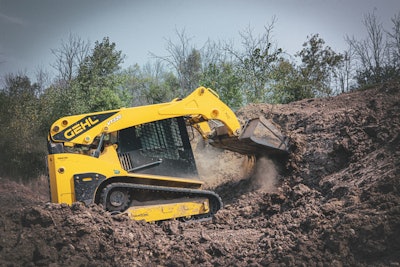 The VT320 is distinct in the Gehl lineup of CTLs. It is the company's largest with a 3,200-pound ROC and the most powerful with 114 net horsepower. Two-speed drive is standard and provides a top travel speed of 7.8 mph. Optional speed control tailors machine operating speeds to applications, independent of engine speed. Optional Hydra-Glide allows the lift arms to float when transporting loads, to reduce spillage, improve comfort and allow higher travel speeds.
The VT320 is distinct in the Gehl lineup of CTLs. It is the company's largest with a 3,200-pound ROC and the most powerful with 114 net horsepower. Two-speed drive is standard and provides a top travel speed of 7.8 mph. Optional speed control tailors machine operating speeds to applications, independent of engine speed. Optional Hydra-Glide allows the lift arms to float when transporting loads, to reduce spillage, improve comfort and allow higher travel speeds.
Burroughs says that such things as travel speed, width and weight are driven by Kubota’s customer base. “As an example, the operating weights of our SVL65-2 and SVL75-2 are under 10,000 pounds, allowing the customer to tow their machine without needing a CDL.”
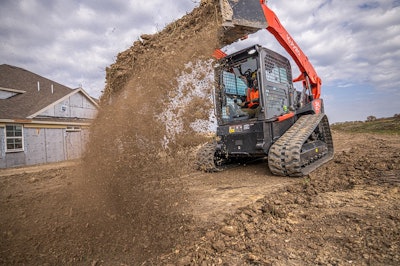 Newest among Kubota’s CTLs is the SVL97-2. Features include a 96-horsepower engine, an ROC of 3,200 pounds, breakout force of 7,961 pounds and a 3.4-foot reach at maximum height. Telematics and a rearview camera are standard. Front LED work lights are optional. Other improvements include a re-engineered DEF system for long-term reliability and better cab sealing to keep out water, dust and debris.
Newest among Kubota’s CTLs is the SVL97-2. Features include a 96-horsepower engine, an ROC of 3,200 pounds, breakout force of 7,961 pounds and a 3.4-foot reach at maximum height. Telematics and a rearview camera are standard. Front LED work lights are optional. Other improvements include a re-engineered DEF system for long-term reliability and better cab sealing to keep out water, dust and debris.
“Honestly, I don’t feel like the market is trying to narrow the gap between skid steers and compact track loaders,” says Padgett. “In the U.S., CTLs have a greater market share due to their versatility and their tracked undercarriage, which makes them more suitable for multi-terrain use. But skid steers have their place, such as for roadwork with frequent spin turns on paved surfaces, which would cause premature wear on tracks.”




